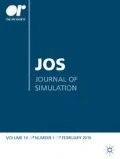Abstract
We describe a Bayesian methodology for fitting deterministic dynamic models, demonstrating how this can be used to estimate the uncertainty around model outputs. By its nature, Bayesian statistics allows all available sources of information to be incorporated: prior knowledge of the model parameter values and data corresponding to the model outputs, thus allowing for a thorough analysis of the uncertainty. The methodology is demonstrated with an example: a deterministic compartmental model of tuberculosis and HIV disease. We discuss how this method might be modified to allow a similar analysis of stochastic simulation models.



Similar content being viewed by others
References
Andradóttir S and Bier VM (2000). Applying Bayesian ideas in simulation. Simulat Pract Theory 8: 253–280.
Badri M, Ehrlich R, Pulerwitz T, Wood R and Maartens G (2002). Tuberculosis should not be considered an AIDS – defining illness in areas with a high tuberculosis prevalence. Int J Tuberculosis Lung Dis 6: 231–237.
Bronson R (1970). Matrix Methods: an Introduction. Academic Press: New York.
Brooks SP and Gelman A (1998). General methods for monitoring convergence of iterative simulations. J Comput Graph Statist 7: 434–455.
Chick SE (1997). Bayesian analysis for simulation input and output. In: Andradóttir S, Healy K, Whithers D and Nelson B (eds). Proceedings of the 1997 Winter Simulation Conference, IEEE, Piscataway: NJ, pp 253–260.
Chick SE (2001). Input distribution selection for simulation experiments: accounting for input uncertainty. Opns Res 49: 744–758.
Chick SE, Soorapanth S and Koopman JS (2003). Inferring infection transmission parameters that influence water treatment decisions. Mngt Sci 49: 920–935.
Corbett EL et al (2003). The growing burden of tuberculosis: global trends and interactions. Arch Int Med 163: 1009–1021.
Currie CSM, Williams BG, Cheng RCH and Dye C (2003). Tuberculosis epidemics driven by HIV: is prevention better than cure? AIDS 17: 2501–2508.
Currie CSM, Floyd K, Williams BG and Dye C (2005). Cost, affordability and cost-effectiveness of strategies to control tuberculosis in countries with high HIV prevalence. BMC Public Health 5: 130.
Fox-Rushby JA and Hanson K (2001). Calculating and presenting disability adjusted life years (DALYs) in cost-effectiveness analysis. Health Policy Plan 16: 326–331.
Garthwaite PH, Kadane JB and O'Hagan A (2005). Statistical methods for eliciting probability distributions. Journal of the American Statistical Association 100: 680–700.
Gelman A (1996). Inference and monitoring convergence. In: Gilks WR, Richardson S and Spiegelhalter DJ (eds). Markov Chain Monte Carlo in Practice. Chapman & Hall: London.
Geyer CJ (1992). Practical Markov Chain Monte Carlo. Statist Sci 7: 473–483.
Gilks WR, Richardson S and Spiegelhalter DJ (1996). Markov Chain Monte Carlo in Practice. Chapman & Hall: London.
Hastings WK (1970). Monte Carlo sampling methods using Markov chains and their applications. Biometrika 57: 97–109.
Inoue K and Chick SE (1998). Comparison of Bayesian and frequentist assessments of uncertainty for selecting the best system. In: Medeiros DJ, Warren EF, Carson JS and Manivannan MS (eds). Proceedings of the 1998 Winter Simulation Conference, IEEE, Piscataway: NJ, pp 727–734.
Kraan B and Bedford T (2005). Probabilistic inversion of expert judgments in the quantification of model uncertainty. Mngt Sci 51: 995–1006.
Law AM and Kelton WD (2000). Simulation Modeling and Analysis. McGraw Hill: New York.
Lee PM (2004). Bayesian Statistics: An Introduction. Hodder Arnold: London.
Metropolis N et al (1953). Equations of state calculations by fast computing machine. J Chem Phys 21: 1087–1091.
Morgan D, Maher C, Mayanja B and Whitworth JAG (2002). Progression to symptomatic disease with people infected with HIV-1 in rural Uganda: prospective cohort study. BMJ 324: 193–197.
Nelder JA and Mead R (1965). A simplex method for function minimization. Comput J 7: 308–313.
Nelson BL, Schmeiser BW, Taaffe MR and Wang J (1997). Approximation-assisted point estimation. Opns Res Lett 20: 109–118.
Oakley JE and O'Hagan A (2002). Bayesian inference for the uncertainty distribution of computer model outputs. Biometrika 89: 769–784.
O'Hagan A and Oakley JE (2004). Probability is perfect, but we can't elicit it perfectly. Reliab Eng Syst Safety 85: 239–248.
Percy DF (2002). Bayesian enhanced strategic decision making for reliability. Eur J Opnl Res 139: 133–145.
Salomon JA and Murray CL (2001). Modelling HIV/AIDS epidemics in Sub-Saharan Africa using seroprevalence data from antenatal clinics. Bull World Health Organ 79: 596–607.
Wiper MP, Pettit LI and Young KDS (2000). Bayesian inference for a Lanchester type combat model. Naval Res Logist 47: 541–558.
World Health Organization (1999). World Health Report. Geneva.
World Health Organization (2002). Global tuberculosis control: surveillance, planning, financing. WHO Report, Geneva.
Acknowledgements
The research was part funded by EPSRC and the World Health Organization as part of a PhD project. Professor Russell Cheng provided useful advice on an earlier draft of this paper. Dr Brian Williams, Dr Chris Dye and Dr Katherine Floyd from the World Health Organization were of assistance in building the TB–HIV model and designing the cost-effectiveness study. I am also grateful to two anonymous referees for their useful comments on an earlier version of this paper.
Author information
Authors and Affiliations
Corresponding author
Rights and permissions
About this article
Cite this article
Currie, C. Bayesian methodology for dynamic modelling. J Simulation 1, 97–107 (2007). https://doi.org/10.1057/palgrave.jos.4250014
Published:
Issue Date:
DOI: https://doi.org/10.1057/palgrave.jos.4250014




